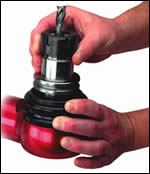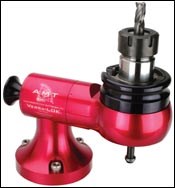Engineering The Toolholder Assembly Process
This assembly and mounting device for V-flange toolholders is designed to make it easier and safer to put toolholders, collets and cutting tools together. The device allows the toolholder to be clamped securely and rotated so that both ends of the assembly are accessible to the user in a comfortable position.
Share





Job shops are famously resourceful. To solve difficult machining problems or make work easier, they often invent their own solutions. Then they realize they might have a product to sell to other machine shops. That is how the Versa-LOK came about. The device, shown at left, is designed to make it easier and safer to put toolholders, collets and cutting tools together. It’s an alternative to using other methods that can damage the toolholder or invite unsafe use of hand tools.
This device was developed by David Lelonek’s company, Automated Machine Technologies, Inc. (AMT), in Orchard Park, New York. The company started out as a contract engineering and manufacturing service company. As this business grew, so did the company’s machining. Assembling cutters, collets and V-flange toolholders became a bottleneck, so Mr. Lelonek had one of his engineers design and build a fixture that worked better and was more versatile than devices currently available. This prototype was functional but not very attractive in appearance. Recently, Mr. Lelonek decided to refine the operation and looks of the toolholder assembly fixture and produce it for the general market.
As pictured here, a spring-loaded lock collar that slides downward allows the toolholder to be inserted, while a guide sleeve inside prevents damage to the taper or flange. Releasing the lock collar engages the clamping mechanism automatically.
The rotating design allows the toolholder to be positioned in any one of eight 45-degree indexing steps for 360-degree total rotation. Pulling and the release a knob at the stub end of the fixture governs rotating freedom. To access the retention stud, for example, the holder can be turned 180 degrees. Various positioning angles allow wrenches and other tools to be applied properly and comfortably whether the user is right- or left-handed.
The device is available currently for Cat-40 tapered toolholders but models for BT, HSK and VDI style toolholders are in development.
An awareness of lean manufacturing principles has made shops more conscious of the need to streamline tool assembly procedures. At the same time, special care of toolholders and cutters has become more urgent because these assets are rising in cost and their performance is often critical in increasingly precise operations. In light of these trends, devices that protect these assets and avoid wasted activity take on double value.
Related Content
-
How to Accelerate Robotic Deburring & Automated Material Removal
Pairing automation with air-driven motors that push cutting tool speeds up to 65,000 RPM with no duty cycle can dramatically improve throughput and improve finishing.
-
Orthopedic Event Discusses Manufacturing Strategies
At the seminar, representatives from multiple companies discussed strategies for making orthopedic devices accurately and efficiently.
-
The Impact of Cutting Teeth Spacing on Machining Stability
Many cutter designs are available, and variable teeth spacing (or variable pitch) cutters can be used to influence milling stability. Let’s discuss why teeth spacing affects stability.
























.png;maxWidth=300;quality=90)

